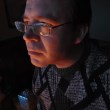1⁄48AVENGER 93 Loyce Deen 353
Page 4
After doing some more stars and bars other items needed to be completed such as the finer photo etch detail. This should drive home why I leave the instrument panel till the end of the project. These control handles and switches look nice but are delicate even with really good VMS Flexy 5K CA.With the decals finally completed on the wings I prepped for fuselage painting by masking off the third color. In total there are four major colors on this aircraft with a fifth being the walkways. The upper fuselage is also in semi gloss while the wing tops are more of a gloss. I still have no idea why this was chosen but that's what the paint call out says. The leading edges are a darker USN/USMC blue and in semi-gloss. Needless to say this is a busy paint job and complicated by having to feather or blend some of the different shades. The dark blue was easily blended free hand thanks to that ugly jig being posable. Note the difference in warmth from an inside light source to outdoors with the wing and fuselage.
Now we get into a more funny part of the interaction between me and Brian. You have no idea how many times we went back and forth with how these walkways should look. It began as a light grey strip then went to black. Then after more research went from a two toned to not being there at all. I said yes to a walkway and he said no, then I switched to no and him yes. Finally the answer came from two seconds in a youtube video. More on that in a bit. Then with even more research came that forth color for all the leading edges. Unfortunately it does not stand out and needs closer examination to be of any note. Just some contrast to add visual depth. It needed to be done regardless so to prevent the paint from pulling up I used de-tacked tape and blue towel instead of taping the entire area of the wings. The horizontal stabilizers would be fine because they didn't have all that work removing decals. At least that was the hope, yet in the end some minor touch ups needed to be done. This got me thinking, "why was my paint lifting?". The cause could have been sanding smooth the primer. I wanted zero orange peal and by polishing the primed surface could have defeated the intent of priming to begin with, thus the paint had nothing to cling to. Lesson learned, yet these touch-ups actually added to the look.
More blending was done to complete the fuselage and the overall look of this version of the sorta TBM-3. Thankfully the bomb-bay doors were not split yet so they could be set in place to match up the intermediate blue with the insignia white. It's time consuming work but really enjoyable once you have your airbrush dialed in and the paint mixed to flow correctly. Mixing paint with thinners is as common as using different grits of sandpaper to get the right surface texture. With Mission Models Paint though it must be exact for your location. Many times did I try to follow the guidelines and many times did I fail. In the end it was a higher ratio of thinner then what they suggest that made the difference.
It was around this time when a welcomed package arrive from across the pond in the form of very fine YAGI Antenna from OWL Parts. There is no comparison, even with the plastic being as good as it is. The OWL antenna are wonderfully thin and make a great improvement. That said, the posts are inaccurate so I opted to use the elliptical shaped plastic ones.
This was the perfect time to address another antenna issue. The post atop the vertical stabilizer on these kits is an accident before it happens being so flimsy and even more so when the parting marks, with the two molds coming together, are cleaned up. A replacement pin would solve the problem being just the right size and infinitely stronger.
Since I was at that part of the model I came up with the not so brilliant idea of cleaning out the well for the horizontal stabilizers and paint on some masking fluid. The idea was to prevent any more layers of paint and clear coat building up, making the task of removing them even harder. This would have worked if it had have been done on bare plastic. The connection with these parts is awesome and worth preserving. However, removing the rubber was not fun and took far longer than I imagined. Again, lessons learned are worth a few mistakes.
Copyright ©2021 by HG Barnes. Images also by copyright holder unless otherwise noted. The views and opinions expressed herein are solely the views and opinions of the authors and/or contributors to this Web site and do not necessarily represent the views and/or opinions of AeroScale, KitMaker Network, or Silver Star Enterrpises. Images also by copyright holder unless otherwise noted. Opinions expressed are those of the author(s) and not necessarily those of AeroScale. All rights reserved. Originally published on: 2020-01-25 00:00:00. Unique Reads: 6833




.JPG)
.JPG)
.JPG)
.JPG)
.JPG)
.JPG)
.JPG)
.JPG)
.JPG)
.JPG)
.JPG)
.JPG)
.JPG)
.JPG)
.JPG)
.JPG)
.JPG)
.JPG)
.JPG)
.JPG)
.JPG)
.JPG)
.JPG)
.JPG)
.JPG)
.JPG)
.JPG)
.JPG)
.JPG)




